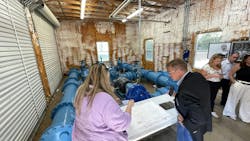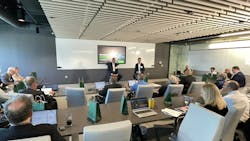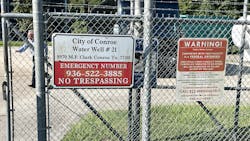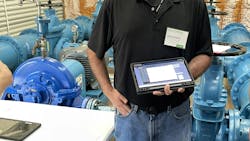Transforming the water industry with open, software-defined automation
Key Highlights
- Open, software-defined automation decouples control logic from proprietary hardware, enabling greater flexibility and scalability in industrial systems.
- The Universal Automation Organization promotes shared standards like IEC 61499, facilitating interoperability across different vendors' equipment.
- Migration to open automation systems can be phased, reducing downtime and allowing utilities to adapt gradually without disrupting service.
Schneider Electric hosted journalists and analysts at an event in Houston, Texas, from September 10-12 to highlight open, software-defined automation and its EcoStruxure Automation Expert.
It’s difficult to talk about the past five years without the mention of COVID-19, but the outfall of the pandemic has created a ripple effect throughout technology sectors. This is a point that Ali Haj Fraj, SVP, digital factory, industrial automation for Schneider Electric focused on during an event in Houston, Texas. He talked about the vast changes that have occurred over the past five years that have required adaptation and focused on the speed of technological innovation as well as the lingering effects of COVID on industry.
Hany Fouda, SVP process automation for Schneider Electric, expanded on these points while speaking at the event, where he talked about the reconfiguration of global trade and the wide range of cybersecurity threats as well as workforce-related issues – all things the water industry is dealing with firsthand.
“This volatility is accelerating,” he said.
Schneider is a global company, operating in over 100 countries with roughly 180 manufacturing facilities. In 2018, the company decided to start a parallel stream with open, software-defined automation.
What is open, software-defined automation?
The open, software-defined automation model takes lessons from IT and brings it back into the industrial space with an aim of delivering a networked ecosystem. It focuses on the pain points of customers with a goal of scaling fast for quick growth, making operation flexible and adaptable.
Industrial automation typically relies on proprietary hardware like PLCs, DCSs and SCADA systems with vendor-specific programming environments. These systems typically run production lines, water plants and energy grids.
Software-defined is an idea borrowed from IT concepts like “software-defined networking.” Instead of tying functionality to proprietary hardware, software-defined automation decouples the control logic from the underlying devices.
The “open” philosophy refers to using open standards, open interfaces and sometimes open-source software to avoid vendor lock-in.
This framework allowed the company to develop its EcoStruxure Automation Expert (EAE).
The importance of EcoStruxure Automation Expert (EAE) and the Universal Automation Organization (UAO)
The Universal Automation Organization (UAO) is a nonprofit, independent organization created to advance “plug and produce” automation based on shared, open standards. It was founded in 2021 as a member-driven organization following the supply chain and shortage issues that occurred post-COVID. It brings together automation vendors, end users, system integrators and technology providers, and has grown to roughly 130 members.
At its core is the IEC 61499 standard, which defines how automation applications are built using reusable, portable “function blocks.” This allows automation applications to run across hardware from different vendors – without rewriting or reprogramming.
The SUEZ Group was an early adopter of EAE, implementing it in some of its water plants where a multitude of differing products are used. Teams in the water industry need to adapt to a fast-moving regulatory landscape and comply with new rules. Automation allowed the teams to create reports for emerging regulations and requirements. One of the main challenges for SUEZ was leak detection, but the switch to EAE allowed easier access to operational data, according to Schneider.
What open, software-defined automation means for the water industry
One of the largest concerns for utilities switching to open, software-defined automation is legacy system migration. Managing the migration of aging, proprietary PLC systems in water and wastewater utilities can be tricky. The key to solving this problem is a step-by-step non-disruptive migration process. This approach minimizes downtime and service disruption by allowing a mix of new and legacy systems to run concurrently.
“You don’t have to migrate all at the same time,” said Sophie Borgne, president of water and environment for Schneider Electric. “You can go step-by-step, which is very helpful to facilitate the migration.”
In Conroe, Texas, one of the fastest growing cities in the U.S., EAE has been implemented in 19 of its drinking water treatment plants. The population has grown from about 60,000 people to roughly 110,000 in the last 10 years, which has placed a growing demand on the water system.
The city’s Well No. 21 system can produce up to 5 million gallons per day (MGD) and can purchase water from the San Jacinto River Authority if necessary. The water can be mixed with the well system during peak flows and the location alternates between well water and the purchased water during lower flows.
At the Well No. 21 system, EAE controls everything from the pumps to the chemical dosing equipment – in this case chlorine for disinfection as well as an iron sequestrant.
Population growth, climate change and a fast-moving regulatory landscape all add up to create an uncertainty for the water sector.
“So how do you deal with uncertainty? You need to have a software that is able to correlate data beyond the pure control system data, and that’s where you get additional benefits of the openness to the IT layer of Automation Expert,” Borgne concluded.
About the Author
Alex Cossin
Associate Editor
Alex Cossin is the associate editor for Waterworld Magazine, Wastewater Digest and Stormwater Solutions, which compose the Endeavor Business Media Water Group. Cossin graduated from Kent State University in 2018 with a Bachelor of Science in Journalism. Cossin can be reached at [email protected].





